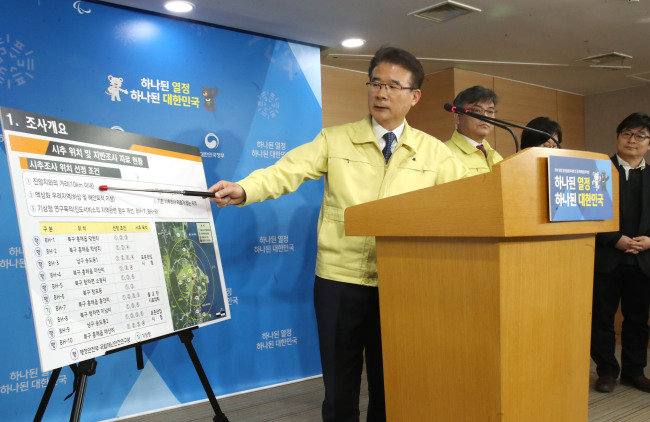The government confirmed Friday that liquefaction caused by last month’s earthquake in Pohang, North Gyeongsang Province, was not at a “worrisome level,” easing safety concerns following the nation’s second strongest quake.
Announcing the interim result of the inspection on soil in a total of 10 locations in Pohang, the Ministry of Interior and Safety said that it had found signs of liquefaction in five locations -- “high” in one location and “low” in four others.
 |
An official from the Ministry of Interior and Safey announces the interim result of the inspection on soil in l0 locations in the quake-hit city of Pohang during a press briefing on Friday. (Yonhap) |
Soil liquefaction is the phenomenon where saturated, loose and sandy soil loses its strength due to an applied stress, such as earthquake shaking, which could heighten urban seismic risks and lead buildings to collapse.
The government-led joint inspection has been underway after some 17 cases of suspected liquefaction were reported in Pohang, since the 5.4-magnitude quake struck the city on Nov. 15.
Ha Ik-soo, a civil engineering professor at Kyungnam University, one of the team that conducted the inspection, said that the liquefaction occurred due to Pohang’s thick sedimentary layers, but liquefaction was not “serious” enough to damage structures.
“The occurrence of liquefaction does not mean an immediate damage to structures. It depends on location, depth and structures,” he said. “Liquefaction is not occurring anymore (in the 10 locations). It seems that it is in the process of being stabilized.”
The government said that it plans to further carry out an inspection on possible liquefaction in other locations, release the result of the testing as well as measures to mitigate its adverse impact within this year.
A 5.4-magnitude quake hit Pohang on Nov. 15, damaging at least 30,878 private establishments and 404 public ones, including 110 schools and 33 roads. All the public facilities and 94.4 percent of the private establishments were restored as of Friday, according to the municipal government.
The quake in Pohang forced as many as nearly 1,100 to leave homes and left some 80 people injured. The quake is estimated to have caused damages worth over 120 billion won ($110 million).
The Moon Jae-in government designated Pohang as a special disaster zone on Nov. 20 to provide its quake-affected residents with emergency, financial and administrative aid as part of a restoration effort.
(
laeticia.ock@heraldcorp.com)






![[Herald Interview] 'Trump will use tariffs as first line of defense for American manufacturing'](http://res.heraldm.com/phpwas/restmb_idxmake.php?idx=644&simg=/content/image/2024/11/26/20241126050017_0.jpg)
![[Exclusive] Hyundai Mobis eyes closer ties with BYD](http://res.heraldm.com/phpwas/restmb_idxmake.php?idx=644&simg=/content/image/2024/11/25/20241125050044_0.jpg)
![[Herald Review] 'Gangnam B-Side' combines social realism with masterful suspense, performance](http://res.heraldm.com/phpwas/restmb_idxmake.php?idx=644&simg=/content/image/2024/11/25/20241125050072_0.jpg)